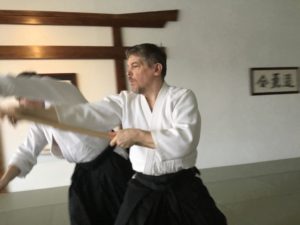We come to our dojo to train so that we’re better able to apply the principles of aikido in our daily lives…
In the kids’ class, we read stories about martial arts principles. Although these stories focus on many concepts, several highlight the importance of awareness in the lives of martial artists. Developing awareness is a clear goal of martial arts training, but it’s also an abstract and somewhat elusive idea for many of us. Concretely, what are we supposed to be more aware of?
This past month I experienced three events that really helped me better understand where increased martial awareness is valuable in our daily lives. Near the beginning of the month, I participated in an endurance event that focuses on team building and leadership development through getting together with a group of strangers and finding creative ways to explore suffering together until we could gel as a team. One of our instructors, a former Army Special Forces sergeant, was clear about the necessity for being aware of how our teammates (these total strangers) were doing with the tasks. A few days later, I was involved in a set of unrelated discussions at work. These conversations had different stakeholders and goals but they also required the same information and the same connections with partners who could help make the goals more accessible. Later in the month, one of the leaders I work with made an observation about the organization I work for, requiring people with a history of conflict to work together. His comment was, ‘I hope they’ve become more aware of what they’re bringing to that conflict.’
In Aikido practice, we are working at becoming more aware in several areas. First, awareness of the needs of those around us. Second, our practice helps us become more aware of the connections and rhythms that exist in the world. And, we are building self-awareness and an ability to continually improve our self-awareness.
By Nate Weed


